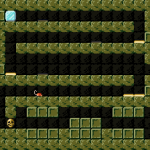The word “paradise” is derived from the Avestan word for “enclosure.”
This fun fact enters my mind every so often on a project. With modern technology, just about anything is possible, and I don’t usually notice at first the cost of all of this possibility.
Today’s case was writing music for Escape Goat. I used Impulse Tracker to compose the score for Soulcaster I and II, and since then I’ve moved into Renoise. It has higher sound quality, runs in Windows, and can load most VST instruments and effects–something I haven’t had access to until now. And I’m blown away, you MIDI sequencing folks have had it made for years–dozens, hundreds of free virtual instruments and effects. Many of them sound as good or better than hardware I paid dearly for ten years ago. Can you believe this is a free instrument? Listen to that quality.
I went on a spree grabbing as many free 80’s style synths and effects that I could find. I came away with about 20 instruments, at least 10 of which were of excellent quality. I could score the whole game with just one of these. The GTG-FM, linked in the above video, is just as capable as a Yamaha DX7, an instrument that went for $2000 new back in the 80’s. And this is just one instrument. I have in my virtual arsenal a synth collection that would have cost a fortune back then. Cause for celebration!
The only problem is, I can (and did) spend a whole night just auditioning the built-in sounds on these guys. They can do such a variety of sounds. Though I started working on a song, it ended up as a love-fest of synth presets. Not much work got done on the actual composition itself. The problem? Too many great sounds. The solution? Force a limitation of them.
It took some time, but I whittled it down to a collection of about 20 instruments and samples I’m going to use as the signature sounds for Escape Goat. I’m only using 3 of the virtual synths. This way I’ll spend less time finding the ultimate bass sound and more time writing the song.
The open desert is scary. Build an enclosure.

